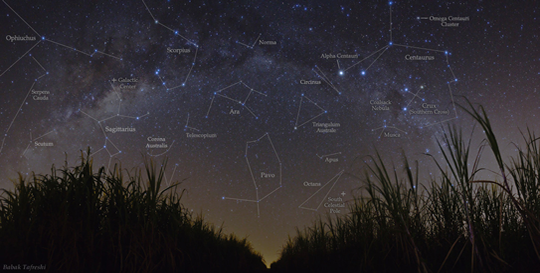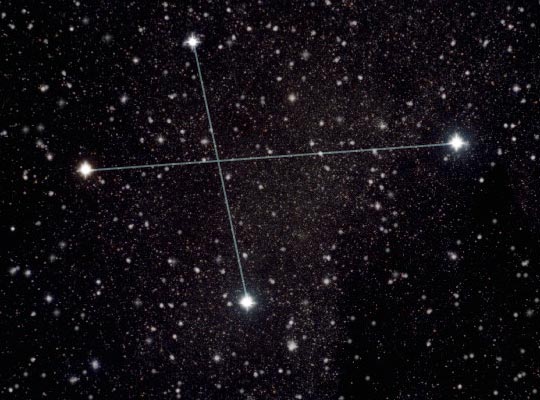The Southern Hemisphere Sky
New Zealand is also known as Aotearoa - The Land of the Long White Cloud. But when the cloud clears at night the sky offers some of the best stargazing opportunities in the world.
The southern night sky contains a greater range of interesting features than does the northern.
This is true for both naked eye and telescope observing. The southern sky claims the three brightest stars (Sirius, Canopus, and Alpha Centauri) and the best examples of almost every type of astronomical object. New Zealand also has a superb view of the Large & Small Magellanic Clouds - two extraordinary galaxies visible to the naked eye that are too far south for northern hemisphere viewers.
Visitors to New Zealand can stare directly into the centre of the Milky Way directly overhead during winter. To see the Southern Cross throughout the entire year one needs to be south of the Tropic of Capricorn.
Photo credit: Babak Tafreshi - twanight.org

Naked eye observing
A common surprise for northern hemisphere visitors, is to find that the northern constellations and the moon appear upside down. To understand why this is so, imagine a face painted on the bottom of a light bulb hanging from the ceiling in the middle of a room. If you were to cross to the other side of the room and turn to look again, the face would then be upside down! Also, remember that 'down under' the Sun, Moon and planets travel through the sky to the north.
The Southern Cross
The five main stars of the Southern Cross belong to a larger group officially known as the constellation Crux. Crux is the smallest constellation in the sky and yet is the most famous group of southern stars. It is a kite-shaped cluster of four bright stars (and one not so bright) all within 16 degrees of each other in the sky. In the course of 24 hours the Cross appears to make a complete circuit in the heavens around a point known as the South Celestial Pole. The mid-point of the line extending from the long axis of the Cross to the bright star Achernar is the directly south.
The Southern Cross appears in various forms on the national flags of four countries: New Zealand, Western Samoa, Papua New Guinea, and Australia. Confirmation that the Cross has been found is the presence of two bright stars called the Pointers: Alpha Centauri and Beta Centauri.

Magellanic Clouds
Two cloud-like patches of light are the neighbouring galaxies known as the Large Magellanic Cloud and the Small Magellanic Cloud. They are about 170,000 light years away and the Large Magellanic Cloud contains about 10,000 million stars. These are the closest galaxies to our own and are a stunning sight whether viewed with the naked eye, binoculars or a telescope. They are considered to be satellite galaxies linked by gravity to the Milky Way. The next closest galaxy is Andromeda 2.2 million light years away.
Milky Way
Stretching across the southern sky is the Milky Way. This is our own disc-shaped galaxy and when we look at the band of light we are looking 'edge on' toward the centre of the galaxy. Apart from the Large Magellanic Cloud, the Small Magellanic Cloud, and the Andromeda Galaxy, all the stars we see in the sky with our eyes are within the Milky Way Galaxy. The borders of the Milky Way Galaxy as we see it are irregular and the Milky Way itself is patchy in parts. One object, which has the appearance of a dark 'hole' in the sky, is a cloud of cosmic dust about 600 light years away - it is known as the Coal Sack. This opaque cloud is next to and nearly as large as the Southern Cross and hides the stars lying behind it.
Telescope Viewing
One of the favourite telescope views near the Southern Cross is the Jewel Box: a compact collection of different coloured stars once described as "a clutch of diamonds with a single ruby."
The Eta Carinae Nebula is one of the truly great sights in the southern skies. It is a vast region containing the remnants of a mighty explosion in the star Eta Carinae. Some 9,000 light years away, it shines with the luminosity of 4 million Suns.
To the naked eye, Omega Centauri looks like a small, hazy circular patch. A good telescope will show its amazing structure, with a grainy appearance like glowing sand. It is the most striking globular cluster in the entire sky as about 100,000 stars occupy a spherical section of space.
Another gem is the 47 Tucanae cluster - a crowded mass of thousands of stars, easy to see in the summer night sky.
The Tarantula Nebula in the Large Magellanic Cloud is one of the most detailed nebulae in the sky. As its name suggests, it has a spidery appearance with a spectacular array of loops and filaments. If it were as close as the Orion Nebula it would appear as large as an outstretched hand at arm's length.